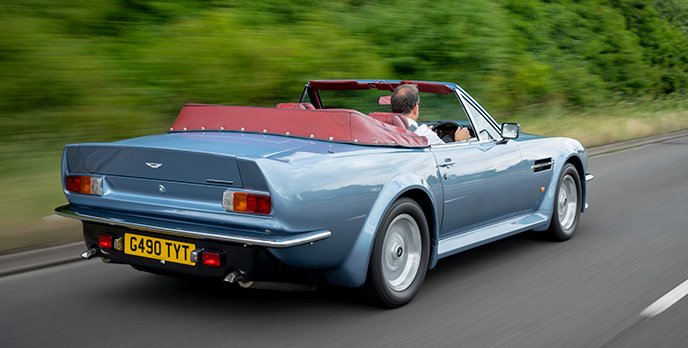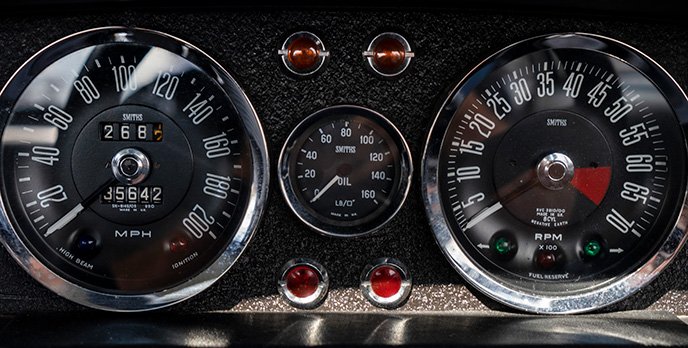Aston Martin Works celebrates the AM V8
23 Oct 2022|1,085 views
Aston Martin Works is celebrating the Aston Martin V8, a car that was instantly recognisable with its small open 'power bulge' on the bonnet, the 'Coke-bottle' flanks, and the use of AM V8 side strake badges completing the exterior styling revisions.
This classical Aston Martin shape would then go on to represent the Aston Martin 'style' for almost two decades, with the last AM V8 style-inspired cars only ending production in 1989 after its genesis in 1972.
This first iteration of the 5.3-litre engined AM V8 produced as much as 320bhp, with around 488Nm of torque. Mated to a ZF five-speed manual gearbox, or optional Chrysler Torqueflite three-speed auto, this was ample power to power the car from zero to 100km/h in around six seconds with a top speed of around 257km/h.
As was often the case in Aston Martin history, production numbers of these early cars were incredibly small by today's standards. A mere 289 AM V8 models of this iteration were built between April 1972 and July 1973. They were succeeded by cars with less complex Weber carburetion, with the later cars also featuring larger bonnet scoops.
It was hailed at its 1977 introduction as 'Britain's first supercar'. It could outrun a Ferrari Daytona in the zero to 100km/h sprint, and on to a top speed of 274km/h thanks to its use of high-performance camshafts, an increased compression ratio, larger inlet valves and bigger carburettors mounted on new manifolds for increased output
The V8 Vantage evolved significantly over the course of its production, which spanned two decades and only ended in 1989 with final deliveries of the last 5.3-litre 'X-Pack' car. It even provided the basis for the hyper rare V8 Vantage Zagato saloon.
The V8 Vantage also left a long lasting impression on fans of James Bond, having been starred in the 1987 Bond film The Living Daylights, which featured a V8 Volante that was 'winterised' into a V8 saloon by the famous Q branch.
This classical Aston Martin shape would then go on to represent the Aston Martin 'style' for almost two decades, with the last AM V8 style-inspired cars only ending production in 1989 after its genesis in 1972.
This first iteration of the 5.3-litre engined AM V8 produced as much as 320bhp, with around 488Nm of torque. Mated to a ZF five-speed manual gearbox, or optional Chrysler Torqueflite three-speed auto, this was ample power to power the car from zero to 100km/h in around six seconds with a top speed of around 257km/h.
As was often the case in Aston Martin history, production numbers of these early cars were incredibly small by today's standards. A mere 289 AM V8 models of this iteration were built between April 1972 and July 1973. They were succeeded by cars with less complex Weber carburetion, with the later cars also featuring larger bonnet scoops.
It was hailed at its 1977 introduction as 'Britain's first supercar'. It could outrun a Ferrari Daytona in the zero to 100km/h sprint, and on to a top speed of 274km/h thanks to its use of high-performance camshafts, an increased compression ratio, larger inlet valves and bigger carburettors mounted on new manifolds for increased output
The V8 Vantage evolved significantly over the course of its production, which spanned two decades and only ended in 1989 with final deliveries of the last 5.3-litre 'X-Pack' car. It even provided the basis for the hyper rare V8 Vantage Zagato saloon.
The V8 Vantage also left a long lasting impression on fans of James Bond, having been starred in the 1987 Bond film The Living Daylights, which featured a V8 Volante that was 'winterised' into a V8 saloon by the famous Q branch.
Aston Martin Works is celebrating the Aston Martin V8, a car that was instantly recognisable with its small open 'power bulge' on the bonnet, the 'Coke-bottle' flanks, and the use of AM V8 side strake badges completing the exterior styling revisions.
This classical Aston Martin shape would then go on to represent the Aston Martin 'style' for almost two decades, with the last AM V8 style-inspired cars only ending production in 1989 after its genesis in 1972.
This first iteration of the 5.3-litre engined AM V8 produced as much as 320bhp, with around 488Nm of torque. Mated to a ZF five-speed manual gearbox, or optional Chrysler Torqueflite three-speed auto, this was ample power to power the car from zero to 100km/h in around six seconds with a top speed of around 257km/h.
As was often the case in Aston Martin history, production numbers of these early cars were incredibly small by today's standards. A mere 289 AM V8 models of this iteration were built between April 1972 and July 1973. They were succeeded by cars with less complex Weber carburetion, with the later cars also featuring larger bonnet scoops.
It was hailed at its 1977 introduction as 'Britain's first supercar'. It could outrun a Ferrari Daytona in the zero to 100km/h sprint, and on to a top speed of 274km/h thanks to its use of high-performance camshafts, an increased compression ratio, larger inlet valves and bigger carburettors mounted on new manifolds for increased output
The V8 Vantage evolved significantly over the course of its production, which spanned two decades and only ended in 1989 with final deliveries of the last 5.3-litre 'X-Pack' car. It even provided the basis for the hyper rare V8 Vantage Zagato saloon.
The V8 Vantage also left a long lasting impression on fans of James Bond, having been starred in the 1987 Bond film The Living Daylights, which featured a V8 Volante that was 'winterised' into a V8 saloon by the famous Q branch.
This classical Aston Martin shape would then go on to represent the Aston Martin 'style' for almost two decades, with the last AM V8 style-inspired cars only ending production in 1989 after its genesis in 1972.
This first iteration of the 5.3-litre engined AM V8 produced as much as 320bhp, with around 488Nm of torque. Mated to a ZF five-speed manual gearbox, or optional Chrysler Torqueflite three-speed auto, this was ample power to power the car from zero to 100km/h in around six seconds with a top speed of around 257km/h.
As was often the case in Aston Martin history, production numbers of these early cars were incredibly small by today's standards. A mere 289 AM V8 models of this iteration were built between April 1972 and July 1973. They were succeeded by cars with less complex Weber carburetion, with the later cars also featuring larger bonnet scoops.
It was hailed at its 1977 introduction as 'Britain's first supercar'. It could outrun a Ferrari Daytona in the zero to 100km/h sprint, and on to a top speed of 274km/h thanks to its use of high-performance camshafts, an increased compression ratio, larger inlet valves and bigger carburettors mounted on new manifolds for increased output
The V8 Vantage evolved significantly over the course of its production, which spanned two decades and only ended in 1989 with final deliveries of the last 5.3-litre 'X-Pack' car. It even provided the basis for the hyper rare V8 Vantage Zagato saloon.
The V8 Vantage also left a long lasting impression on fans of James Bond, having been starred in the 1987 Bond film The Living Daylights, which featured a V8 Volante that was 'winterised' into a V8 saloon by the famous Q branch.
Latest COE Prices
August 2025 | 1st BIDDING
NEXT TENDER: 20 Aug 2025
CAT A$102,009
CAT B$123,498
CAT C$70,001
CAT E$122,334
View Full Results Thank You For Your Subscription.


























